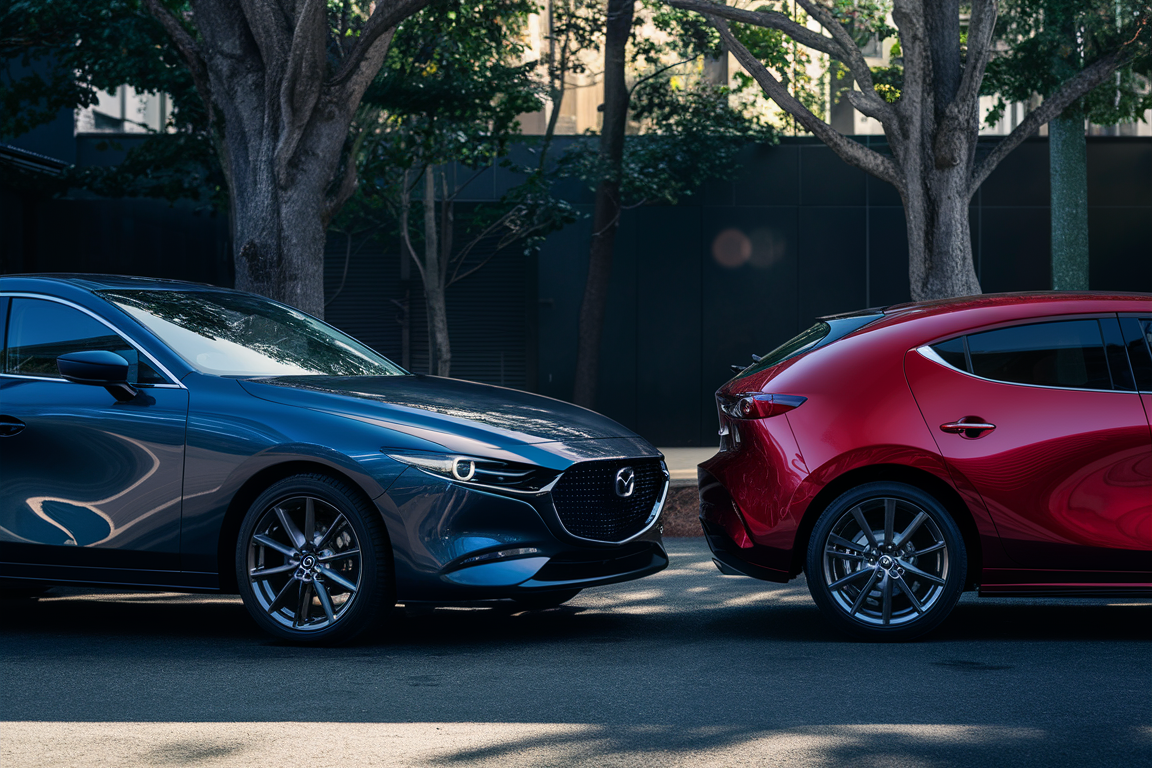Mazda 3 Sedan vs Hatchback: Which one is right for you?
When it comes to the Mazda 3, car enthusiasts are often faced with a dilemma – should they go for the sedan or the hatchback variant? Both offer unique features and cater to different driving preferences. In this comprehensive guide, Car Tips & Guide will dive deep into the key differences between the Mazda 3 sedan and hatchback to help you make an informed decision.
Exterior Design and Aesthetics

The Mazda 3 sedan and hatchback share a similar striking, athletic design language that is a hallmark of the brand. However, the two body styles offer distinct visual characteristics.
Mazda 3 Sedan
The sedan variant boasts a more traditional, elegant silhouette with a prominent trunk and a sleek, streamlined profile. Its longer, more conventional shape exudes a sense of sophistication and refinement.
Mazda 3 Hatchback
In contrast, the hatchback model features a more dynamic, sporty appearance. The hatchback’s sloping roofline and tailgate design give it a more compact, agile look that appeals to those seeking a bolder, more expressive style.
Interior Space and Practicality
One of the key differences between the two Mazda 3 variants lies in their interior capacities and cargo-carrying capabilities.
Mazda 3 Sedan
The sedan offers a more traditional, structured interior layout with a dedicated trunk for storage. This configuration provides ample space for larger items and a more defined separation between the passenger and cargo areas.
Mazda 3 Hatchback
The hatchback, on the other hand, features a more versatile and spacious interior with the added benefit of a lift-up tailgate. This design allows for easier loading and unloading of larger or bulkier items, making it a practical choice for those with active lifestyles or who need to transport more cargo.
Performance and Driving Dynamics
Both the Mazda 3 sedan and hatchback share the same powertrain options, delivering a similarly engaging and responsive driving experience.
Mazda 3 Sedan
The sedan’s slightly longer wheelbase and more traditional weight distribution can contribute to a slightly more balanced and composed handling feel, particularly at higher speeds.
Mazda 3 Hatchback
The hatchback’s more compact dimensions and slightly lighter overall weight can result in a slightly more agile and nimble handling character, especially in tight, twisty roads.
Fuel Economy and Efficiency
When it comes to fuel efficiency, the Mazda 3 sedan and hatchback models typically offer comparable performance, with only minor differences that may vary depending on specific trim levels and engine configurations.
Pricing and Availability
As with most vehicle comparisons, the pricing and availability of the Mazda 3 sedan and hatchback can vary based on region, trim levels, and market conditions. It’s essential to check with your local Mazda dealer or authoritative industry sources for the most up-to-date information.
Detailed Specifications Comparison
Dimensions
- Mazda 3 Sedan
- Length: 183.5 inches
- Width: 70.7 inches
- Height: 56.7 inches
- Wheelbase: 107.3 inches
- Mazda 3 Hatchback
- Length: 175.6 inches
- Width: 70.7 inches
- Height: 56.9 inches
- Wheelbase: 107.3 inches
The sedan has a longer overall length, while the hatchback is slightly shorter and more compact.
Cargo Space
- Mazda 3 Sedan
- Trunk volume: 13.2 cubic feet
- Mazda 3 Hatchback
- Cargo volume (rear seats up): 20.1 cubic feet
- Cargo volume (rear seats folded): 47.1 cubic feet
The hatchback offers significantly more cargo space, thanks to its practical liftgate design and fold-down rear seats.
Powertrain Options
- Both the sedan and hatchback are available with the same engine choices:
- 2.0-liter Skyactiv-G four-cylinder (155 hp, 150 lb-ft of torque)
- 2.5-liter Skyactiv-G four-cylinder (186 hp, 186 lb-ft of torque)
- Transmission options include a 6-speed manual or 6-speed automatic
The powertrain specifications are identical between the two body styles.
Fuel Economy Ratings (EPA estimates)
- Mazda 3 Sedan
- 2.0L engine: Up to 28 mpg city, 36 mpg highway
- 2.5L engine: Up to 26 mpg city, 35 mpg highway
- Mazda 3 Hatchback
- 2.0L engine: Up to 27 mpg city, 36 mpg highway
- 2.5L engine: Up to 25 mpg city, 35 mpg highway
The sedan and hatchback achieve very similar fuel economy ratings.
Key Similarities and Differences
Similarities:
- Shared powertrain options and performance capabilities
- Nearly identical fuel economy ratings
- Same high-quality, driver-focused interior design
Differences:
- Exterior design and styling – Sedan is more traditional, Hatchback is more sporty
- Cargo capacity – Hatchback offers significantly more rear storage space
- Dimensions – Sedan is longer, Hatchback is more compact
- Pricing – Hatchback models tend to be slightly more affordable
Target Buyer Profiles
Mazda 3 Sedan:
- Buyers seeking a more refined, elegant sedan style
- Those who prioritize a traditional trunk for storage
- Commuters who don’t require maximum cargo space
Mazda 3 Hatchback:
- Buyers drawn to a sportier, more distinctive hatchback design
- Those with active lifestyles who need versatile cargo room
- Buyers who value a more compact, maneuverable package
Conclusion
In the end, the choice between the Mazda 3 sedan and hatchback comes down to your personal preferences, driving needs, and lifestyle. The sedan offers a more traditional, elegant design and a more structured interior, while the hatchback provides a more dynamic, sporty look and enhanced cargo versatility. Carefully consider your priorities, test drive both models, and make the decision that best fits your unique requirements.

Related Posts
Mazda CX90 vs Honda Pilot: A Comprehensive Comparison
2023 Mazda CX-30 Interior: A Sophisticated and Spacious Cabin Experience
Is a Miata a Sports Car?